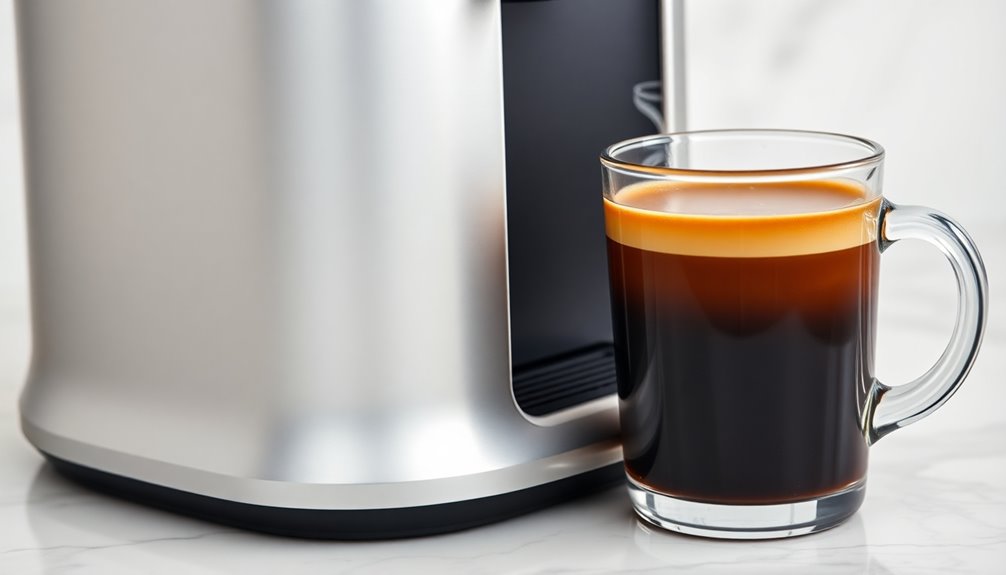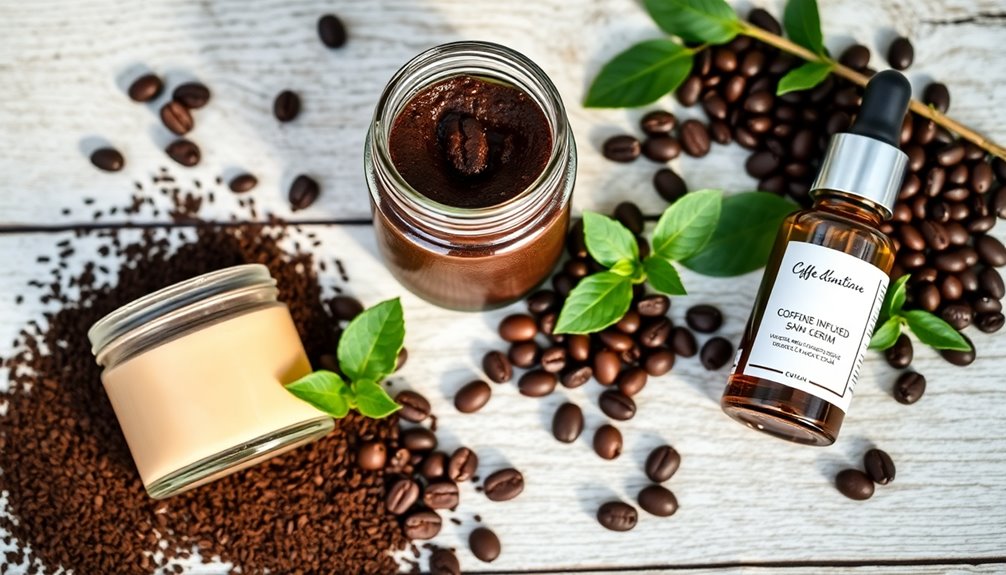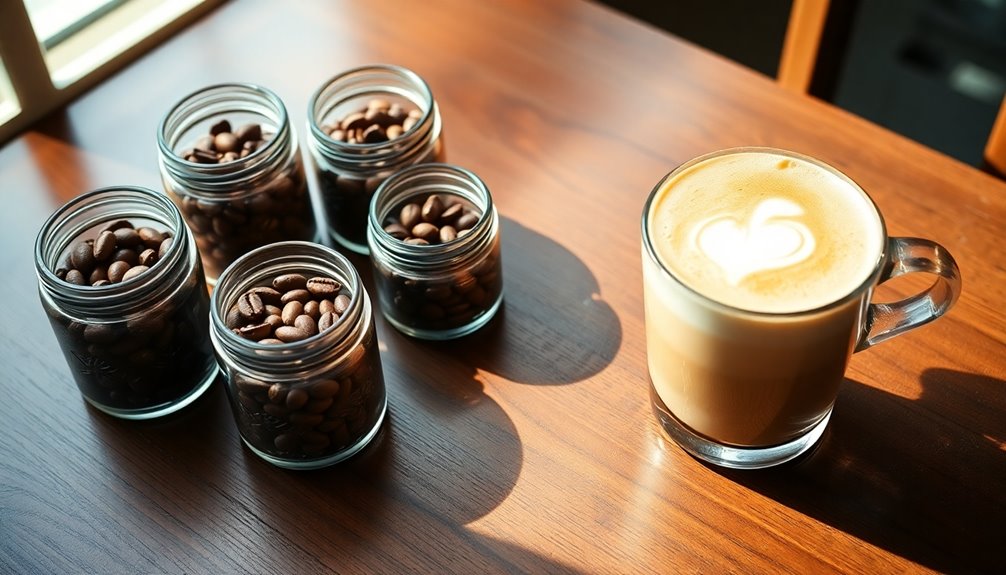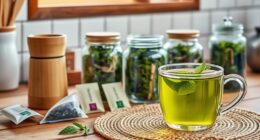To learn espresso making, start by choosing the right portafilter and grinding fresh coffee beans just before brewing. Understanding the types of coffee beans, like Arabica and Robusta, helps you select the best flavors. Tamping the grounds evenly is crucial for balanced extraction, and you should maintain your equipment to ensure high-quality results. Aim for a brewing temperature between 195°F to 205°F and enjoy the richness of the crema. With practice, you'll refine your skills and appreciate the nuances of your brew. There's much more to explore in the art of espresso and coffee crafting!
Key Takeaways
- Select the right portafilter and grind coffee just before brewing for optimal freshness and flavor extraction.
- Understand coffee bean types like Arabica and Robusta to enhance espresso quality based on their unique characteristics.
- Use a burr grinder for a fine, even grind size to ensure balanced flavor in your espresso.
- Maintain proper tamping pressure and brewing temperature to avoid channeling and achieve consistent extraction.
- Regularly clean and maintain your espresso equipment to ensure long-lasting performance and quality espresso.
Understanding Espresso Making

When you dive into understanding espresso making, it's essential to grasp both the equipment and the process involved.
First, choose the right portafilter based on the number of shots you need. Grind your coffee just before use to prevent staleness, and preheat your espresso machine. Selecting the right portafilter ensures optimal extraction of coffee and enhances the overall flavor profile of your drink.
Once it's ready, lock in the portafilter under the group head to create a proper seal. Purge the machine to clear out old grounds before inserting the portafilter.
Pay attention to dialing in the grind for optimal extraction, measuring and tamping the coffee evenly.
Finally, monitor your shot as it extracts, adjusting variables like dose and grind as needed. Keeping everything clean and well-maintained ensures consistent, high-quality espresso.
Types of Coffee Beans

Coffee beans come in several varieties, each offering distinct flavors and characteristics that influence your brewing experience.
The most popular is Arabica, known for its smooth, sweet, and fruity notes. It thrives in high altitudes and accounts for over 60% of global production. Arabica trees are small and easy to care for, making them a preferred choice for many coffee growers. Additionally, drinking coffee's health benefits can enhance your overall well-being.
Then there's Robusta, which packs a punch with double the caffeine and a more bitter profile, making it a favorite for espresso blends.
Excelsa adds a unique twist with its complex flavor profile, blending light and dark roast traits.
Lastly, Liberica is rare and has a smoky, fruity aroma, often reserved for specialty coffee. Understanding these types will help you choose the right beans for your perfect brew.
Characteristics of Coffee Varieties

Each coffee variety brings its own unique characteristics that can significantly impact your brewing experience. For example, the Ethiopian Yirgacheffe coffee variety is known for its fruity and floral notes, while the Colombian Supremo variety offers a balanced and mild flavor. When selecting a coffee variety, it’s important to consider factors such as roast level, grind size, and coffee pod compatibility to ensure that you get the best possible taste from your brew. Different varieties may require specific brewing methods or be best suited for certain types of coffee pod machines. Therefore, understanding the compatibility of the coffee variety with your brewing equipment is essential for achieving the desired flavors in your cup of coffee.
Coffea Arabica, which comprises 56% of global production, offers a mild flavor with fruity and floral notes but requires specific growing conditions. Additionally, Arabica is vulnerable to diseases, which necessitates careful cultivation practices to maintain quality.
In contrast, Coffea Robusta, accounting for 44% of production, boasts nearly double the caffeine content and a bold, bitter taste, thriving in harsher climates.
Coffea Excelsa, a variety of Liberica, enhances blends with its tart and mysterious flavor, while Coffea Liberica itself provides a bold and unique profile, thanks to its adaptability.
Understanding these differences helps you choose the right beans for your espresso, ensuring you enjoy the full spectrum of coffee flavors.
Grinding Techniques for Espresso

Mastering grinding techniques is crucial for achieving the perfect espresso. Invest in a burr grinder rather than a blade grinder to ensure uniform grind sizes and avoid overheating your beans.
Choose between conical and flat burrs, with flat burr grinders often preferred for their precision. Aim for a fine grind, resembling finer salt, to prevent weak or bitter flavors. Adjust the grind size based on your machine and desired espresso volume, paying attention to specific settings for different grinders.
Always grind your coffee just before extraction for optimal flavor, and don't overlook the importance of regular grinder maintenance. Moreover, using freshly ground coffee ensures that you minimize oxidation and flavor loss, which can significantly impact your espresso's taste. Calibration and consistency are key, so experiment and fine-tune your grind settings for the best results.
The Importance of Tamping

After you've perfected your grinding technique, the next step in crafting a great espresso is tamping. This process ensures even distribution of coffee grounds, allowing water to flow uniformly during brewing.
When you tamp correctly, you prevent gaps that could lead to uneven extraction, enhancing the flavor of your shot. Aim for a pressure between 20 to 30 pounds, applying consistent force each time.
Hold the tamper like a doorknob, maintaining a straight wrist and bent elbow for better control. Make sure the coffee puck is even, about 1/8 inch below the portafilter's top.
With proper tamping, you'll create resistance that extracts more oils and flavor, giving you a richer espresso experience. Additionally, using proper tamping technique helps you avoid channeling, ensuring balanced extraction throughout the coffee grounds.
Essential Espresso Equipment

When it comes to brewing a perfect espresso, having the right equipment is essential. You'll need a quality espresso machine equipped with a boiler, group head, and portafilter. The boiler heats water, while the group head ensures even water distribution over the coffee grounds.
A steam wand is crucial for frothing milk, and a water reservoir keeps everything flowing smoothly. Espresso scales are essential for precise shot measurements and ratios, ensuring that you achieve the desired flavor profile every time.
Don't forget your barista tools—like a knock-box for used pucks, a tamper for even compression, and a scale for precise measurements. Accessories like a blind shaker and naked portafilter enhance your brewing process.
Finally, maintain your equipment with cleaning tools like Cafiza and brushes for a consistently great espresso experience.
Quality Indicators in Espresso

The right equipment sets the stage for a great espresso, but it's the quality indicators during and after extraction that truly define the experience.
As you extract, look for a crema that's hazelnut to dark brown with reddish hues and a fine texture. The aroma should be intense, complemented by balanced flavors devoid of strong acidity or bitterness. A full-bodied espresso with a smooth mouthfeel is essential—avoid watery or overly bitter textures. Consistent technical parameters such as a 7g coffee dose and 90°C water temperature are crucial for achieving the desired extraction.
After sipping, you'll want a pleasant, lingering aftertaste. Be aware of extraction issues: under-extraction can result in light crema and excessive acidity, while over-extraction may lead to dark crema and pronounced bitterness.
Monitoring these indicators ensures a consistently great espresso.
Serving and Presentation Tips

To elevate your espresso experience, attention to serving and presentation is key.
Start with pre-warmed, small demitasse cups to keep your espresso hot and aromatic, aiming for a serving temperature of 67-70°C (153-158°F).
Ensure the crema is thick and velvety, enhancing both aroma and visual appeal. Consider adding latte art for an intricate touch. High-quality coffee beans are essential to achieving the perfect espresso flavor, so choose your beans carefully.
Small garnishes like a slice of lemon peel or a chocolate-covered coffee bean can elevate the presentation. Offering a glass of sparkling water as a palate cleanser adds a nice touch, too.
Lastly, keep all your cups, saucers, and spoons spotless—they reflect your care in crafting the perfect espresso and enhance the overall customer experience.
Mastering the Espresso Process

Crafting the perfect espresso goes beyond serving; it starts with mastering the entire brewing process.
First, warm up your machine to 200°F (93°C) and use fresh, filtered water for the best flavor extraction. Choose high-quality, freshly roasted beans, measuring 18 grams for a double shot. Grind them to a fine consistency, akin to powdered sugar.
Next, prepare the portafilter by selecting the correct basket and leveling off the coffee grounds. Tamp with 18kg of pressure, ensuring even extraction. Flush the group head before locking in the portafilter, and start brewing immediately.
Aim for a 25-30 second brew time, watching for a rich crema. Brewing temperature is crucial for optimal flavor extraction, so ensure your machine is set between 195°F to 205°F (90°C to 96°C). Lastly, maintain your equipment by regularly cleaning and calibrating to ensure optimal espresso quality.
Frequently Asked Questions
Can I Use Pre-Ground Coffee for Espresso?
You can use pre-ground coffee for espresso, but it mightn't yield the best results.
Pre-ground coffee often has inconsistent grind sizes, which can impact extraction and flavor. If you choose to use it, make sure to find a finely ground option labeled for espresso.
Remember, freshly ground coffee typically offers better aroma and taste, so consider investing in a grinder for a more flavorful espresso experience.
It's worth it!
How Do I Clean My Espresso Machine Effectively?
To clean your espresso machine effectively, start by purging the group head after each shot.
At the end of the day, scrub it with an espresso brush and a cleaning cloth.
Wash the steam wand before and after use to prevent milk buildup.
Backflush weekly with a blank portafilter and cleaning powder.
Don't forget to check filters and clean the grinder regularly to maintain optimal performance and flavor consistency.
What Is the Best Water to Use for Espresso?
To brew the best espresso, you should use filtered tap water or mineralized water that meets the TDS criteria of 90-150 ppm.
These options enhance flavor and protect your machine. Avoid distilled or reverse osmosis water, as they lack essential minerals and can negatively impact taste.
Always use fresh water, ensuring it's free of extraneous odors.
Regularly check local water reports to ensure your water meets the ideal characteristics for optimal results.
How Can I Tell if My Espresso Is Over-Extracted?
You can tell if your espresso is over-extracted by tasting intense bitterness that overshadows other flavors and leaves an unpleasant aftertaste.
If the espresso feels hollow and lacks richness, that's a sign too.
You'll notice a dry, sandpapery sensation on your tongue, and the crema will appear thin.
Visually, you might see dark blotches with white spots, and if it takes longer than 30 seconds to brew, it's likely over-extracted.
Can I Use Flavored Coffee Beans for Espresso?
Yes, you can use flavored coffee beans for espresso, but it's important to be cautious.
Flavored beans often contain oils that can clog your machine, so you'll need to clean it more frequently. While they can add unique tastes, they mightn't suit every espresso preference.
For best results, stick to medium roasts for balance, and remember that consistency in flavor can be tricky. Regular maintenance will help prevent any unwanted residual flavors.
Conclusion
Now that you've explored the world of espresso making, you're ready to dive into this fine craft. By understanding the nuances of coffee beans, perfecting your grind, and mastering tamping techniques, you can elevate your coffee game. Remember, the right equipment and attention to detail can make all the difference. So, experiment with different beans, refine your skills, and enjoy every cup you brew. With practice, you'll become a true espresso aficionado!










